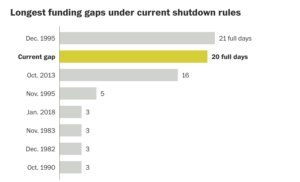Today marks 20 days since the budget impasse between the Legislative and the Executive branches which shut down the Federal Government on December 22, 2018 — bringing to mind the memorable scene in 1993 political comedy, Dave. A Presidential impersonator (Kevin Kline) and his accountant gather Washington power brokers peacefully around a conference table and rework the budget — all to save a beloved program of the First Lady’s (Sigourney Weaver). The budget is balanced to the last dollar to great applause. That is the stuff of Hollywood!
Today’s budget impasse is less about how to find $5 billion dollars (a fraction of the $4.4 trillion dollar annual budget) for a barrier at the Southern border, and more about a political calculation between the White House and the new House majority.
While priorities on fixing the broken immigration system differ between parties, the fact that the system is broken and the need for improved border enforcement has seen consensus across the political aisle. Both George W. Bush (May 2006) and Barack Obama (September 2014) addressed the nation on the topic of immigration. President Obama also referred to the U.S. border situation as a humanitarian crisis. President Trump has made the topic a priority, while acquiescing to previous congressional demands to strip border funding requests from prior government funding bills. What we are watching today is the acknowledgement that this shutdown bargaining chip is one of the few leverage points President Trump will have to achieve any legislative branch victories over the next two years, and a legislative branch majority that doesn’t want to award this political victory to the sitting president of the opposing party.
Meanwhile, about 75 percent of the government has already been funded by Congress, while major departments such as Homeland Security, Justice, Agriculture and Interior remain unfunded.

Washington Post
The story is not a new one. Shutdowns are a recent phenomenon beginning in 1978 when then Attorney General Benjamin Civiletti declared that the federal government could not proceed with its work until funded by Congress. Since then, there have been 15 government shutdowns.
“Right now, when Congress cannot agree on how to spend money, it passes a continuing resolution, or CR, which continues federal agencies’ financing for a given period of time.” Some are arguing for automatic CRs which “would absolve Congress from the responsibility of passing new CRs, preventing both quick financing lapses and big, painful shutdowns.” (The Atlantic). Could that be the answer?
At the start of the 2018 fiscal year, 10 states began their legislative calendar without approved budgets – the third straight year for Illinois. From disagreements over a $2 billion dollar funding gap in Pennsylvania to transportation costs in Wisconsin, budget negotiations plagued one fifth of the states. Taking a page from Illinois (the state with the worst credit rating), operating a government without a budget can lead to severe financial consequences.
“And while voters don’t like shutdowns, they don’t tend to hate them enough to punish the politicians responsible at the polls. For that reason, along with the leverage that shutdowns give politicians over one another and the motivation they give both sides to broker a deal, they tend to happen again and again.” (Atlantic).
The continued consequences from a shutdown might be what brings opposing sides to the table to negotiate. Without it, politicians might not be incentivized to reach agreement. The budget will always remain the way that Washington sets its agenda, defines the direction of policy, and provides for the welfare of its citizens/voters. And in a divided government, tough negotiation regarding how money is spent (i.e. controlling the purse) is a key part of the democratic process.